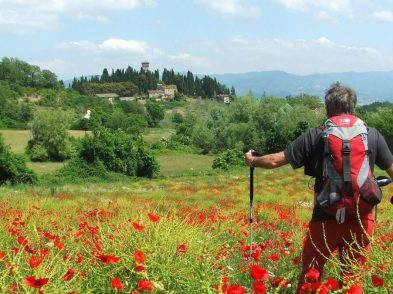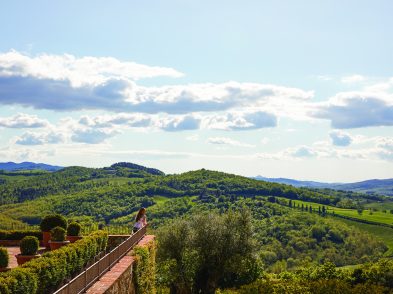The second half of the twentieth century witnessed the steady development of art towards interpenetration with everyday life. Dada and Surrealism influenced postwar generations, especially in Paris where Yves Klein, Arman, Daniel Spoerri and others created anti-heroic work that aimed at unmediated interaction with society. Their openness to chance events and uncertain processes made important contributions to the development of happening and performance art.
The Centro per l’Arte Contemporanea ‘Luigi Pecci’ in Prato is offering an excellent chance to savor the radical developments of this period: the occasion is the first Italian retrospective of Daniel Spoerri’s career, appropriately subtitled Non per caso (‘not by chance’), on view until April 29. The exhibition of 150 works touches on all of Spoerri’s main interests: collections of objects, food, anatomy, anthropology, genetics, fetishes, magic, mystery and death. Even a rare and impressive Reconstruction of Room n.13 in the Hôtel Carcassonne is on view.
Romanian born, Daniel arrived in Zurich at age 12 when the Spoerri family was fleeing fascist persecution in their homeland. Of his youth he has written‘I think I became a collector as a child when I would pick up all kinds of things’.After study of ballet, theater and poetry, his early career revolved around dance and the stage; contact with avant-garde developments in Paris led him to move to the French capital, where he soon fell in with Yves Klein, with whom he signed the Nouveau Réalisme manifesto in 1960.
The previous year he had made friends with the masters of chance and the ready-made, Marcel Duchamp and Man Ray, and their influence is immediately seen in Spoerri’s first visual art. His tableaux-pièges (painting-traps) join his obsession with ready-made objects to his talent as a director to stage them. The first shocking canvases, created in 1960, revealed the most striking of the artist’s obsessions, food, which he treats in a deliberately desecrating way. Spoerri states, ‘Situations discovered by chance, be they orderly or disorderly, are fixed (trapped)—just as they have been found—on their support in that specific momentthe only thing that has been changed is the orientation of the viewer’s gaze’.Thus the surface of the canvas is a tabletop tipped towards us at a dizzying 90-degree angle to the floor; there we find the remains of a meal, including the place setting with crumbs and stains, leftover food, and such chance objects, such as ashtrays with cigarette butts and dirty napkins. Often deliberately revolting, these compositions should be taken as a kind of vanitas, emphasizing the ephemeral quality of our lives. Nowadays, these pieces also seem a tragic foretelling of our relationship to the use/waste of resources.
During his career Spoerri anticipated some of the major trends in late-twentieth-century art: he was the first to produce the serial reproduction of art in ‘multiples’; he conceived of a ‘licensed’ art guaranteed by special patents; he actively participated in the Fluxus movement. He has also exerted a lasting influence on younger generations by teaching at the most prestigious art academies throughout Europe. He has said that he would like to be remembered‘as a dancer, a man of theater and of cuisine, an artist who has united in one life, my own, many different lives’.
One remarkable aspect of his multifaceted career is specifically bound to Tuscany. In 1989 he acquired 17 hectares of land near Seggiano (a province of Grosseto), in the area sloping up towards Monte Amiata. The rundown buildings required attention but he was soon attracted to the wide olive groves as ideal sites where he could install some bronze sculptures. The most spectacular is certainly Unicorni-Omphalos, ombelico del mondo, installed in a clearing overlooking a breathtaking view. Here, a low, ring-shaped, stone wall is the base upon which a series of bronze horse skulls have been arranged at intervals, all facing the center of the circle. From the forehead of each rises a straight ‘horn’ that is more similar to a lance both for its remarkable length and for the empty knight’s glove that grips it halfway up. Magic and mystery are powerfully felt here but can also be discerned, to a lesser degree, throughout the rest of the Hic Terminus Haeret sculpture park.
Over the years Spoerri has invited other world-renowned artists (such as Soto, Karavan, Arman, M. Oppenheim, and Tinguely) to join him in conceiving artwork for the site and today the garden hosts over eighty installations. The activity carried out by Spoerri and his colleagues in Seggiano is the subject of the last exhibition hall in the Pecci. While the Spoerri retrospective is on display, the Pecci Museum will organize visits to the artist’s Seggiano garden (for more information call 057/45317) as well as two days of study, ‘The Phenomenology of the Object in Twentieth Century Art’, conducted by the University of Siena Art History Department (in Seggiano on March 29; and in Prato on March 30; for information call 057/7233635).
Daniel Spoerri: non per caso is on display from February 3-April 29 at the Centro per l’arte Contemporanea Luigi Pecci, viale della Repubblica 129, Prato; Wednesday–Monday, 10:00am–7:00 pm
Il Giardino di Daniel Spoerri can be visited from Easter through October 31, Tuesday–Sunday 11:00am–7pm; Entrance fee: adults 10 euro; children under 8 free. From November to March visits are by appointment only; telephone: 056/4950805; fax 950553.






